Pushing through a damp, flower-decked meadow on the hilltop, we reach the edge of a narrow valley filled with giant bog rhubarb. Before he plunges down into it Nelu, the hunter, turns to me with a grin: “In this vegetation, the bears can just pop up – right in front of you!”
I am wishing that I had changed out of my cycling gear. These shoes have no grip and the shorts are much too tight for escape manoeuvres.
How did this happen, I ask myself, as I follow Nelu into the tall, spiky vegetation. Only an hour ago I was on a cycle tour in the Romanian mountains – now, fired up with plum brandy, I’m chasing bears through a landscape that could only be dreamed up by the Brothers Grimm: steep-sided hills covered in flowers, deep gorges and dark brooding forests.
I glance down at my feet and there, in a patch of dried mud, is a wolf’s footprint. Nelu and my cycling guide, Mircea Crisbasanu, come over and confirm it. Yes, a wolf has passed this way – maybe last night. Don’t worry, they assure me, they only attack in winter when they’re hungry.
To our left there is the edge of the forest: dark and silent. To the right a hidden stream is roaring. There is a heightened quality to the atmosphere and every detail is perfectly chiselled by the twilight. How good can plum brandy be? Is this some alcohol-induced hallucination?
The cool mountain air of the Carpathians, and the damp scratches of the prickly plants around my bare legs seem real enough. Mircea and Nelu plunge into the bog rhubarb, heading deeper and deeper into the wilds, oblivious to the fading light, the rising moon and the possible effects of Lycra on local predators – lycranthropy?
I go after them, trying very hard to keep up. We want to spot a bear. Nelu has promised. I think his promises are serious – like his brandy.
Romania. Before I arrived the name conjured up conflicting images. On one side there was a literary element: William Blacker’s Along the Enchanted Way and Patrick Leigh Fermor’s Between the Woods and the Water – gorgeous, evocative, and – I calculated – highly romanticised. Then there was the other, less attractive, side of the equation provided by TV programmes and newspapers: dilapidated orphanages, Ceausescu’s dead face, Roma people being packed into French coaches, and some nasty Stalinist architecture. Given the apparent incompatibility of these two, I should have predicted that it was going to be unpredictable, but somehow I didn’t.
The plan was to cycle through an area of mountains that sees few visitors, Romanian or foreign.
“It’s like an elbow in the Carpathian chain,” Mircea explains as we drive from Bucharest’s Baneasa airport (brutal 1950s architecture, exactly as expected). “You’ll see. It’s only a day’s drive from Bucharest but very wild and remote. Are you okay with sleeping in haystacks if we have to?”
Mircea is a young Romanian who learned to love cycling while studying engineering in Holland. He came home to an economic depression and, rather than engaging in civil works, started a cycle-touring company instead. He is, I am to discover, a great travelling companion, if a little overenthusiastic when it comes to searching for bears at twilight in giant rhubarb forests. We drop the car in the small town of Berca at the foot of the hills and, next morning, load up our bikes and set out.
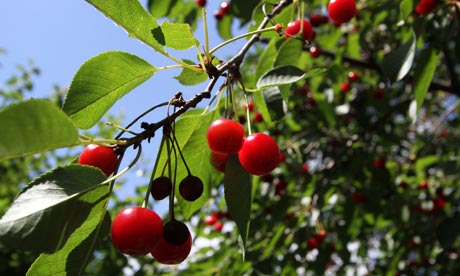 Sour cherries on the treeWe roll along quiet roads admiring the small houses, each with a garden filled with sour cherry trees and vines. Outside every house is a bench where the inhabitants can sit and watch the world go by. The majority are elderly, many of the young people having abandoned bucolic bliss for the delights of the city.
Sour cherries on the treeWe roll along quiet roads admiring the small houses, each with a garden filled with sour cherry trees and vines. Outside every house is a bench where the inhabitants can sit and watch the world go by. The majority are elderly, many of the young people having abandoned bucolic bliss for the delights of the city.
Greetings are important: “I kiss your hand!” is my favourite, so I learn it and practise, calling “saru’mana!” as we pass. It is, I shortly discover, only intended for older women, so I revert to “sa traiti“, “May you live long”, which turns out to be only for older men.
Smiles are rare, and not just because of my faulty grasp of Romanian. There is wariness, if not bemusement. Cycling for pleasure is something of a novelty in these parts. Or perhaps it is because the region has been trampled by invaders so often that another incoming wave of people in helmets – this time plastic ones – is given a cautious welcome.
“The place we’re heading for is said to be the ancient kingdom of Colchis,” Mircea tells me. “That’s where Jason and the Argonauts came to claim the golden fleece, and where there is a fountain of everlasting youth.”
Is he serious? I’m not sure. The destination of the mythical Argonauts has usually been placed on the eastern shores of the Black Sea, but I have no objection to it being relocated. It is always fascinating to see how people drag useful myths towards their own landscape, wreathing their hills and valleys with mystery, magic and pilgrim potential. Think Glastonbury and Joseph of Arimathea.
Mircea is grinning. “There’s a spring up in the mountains where we are going and they do say its waters rejuvenate you.”
For the moment, however, we are drawn away from thoughts of long life with a stop at a chapel where a funeral is taking place. I am ushered in and a lighted candle, its base wrapped in a traditional cotton handkerchief, is pressed into my hand. A nun has died and is lying in an open coffin while local people and other nuns sing laments in a simple and moving ceremony. Following the gestured instructions of an elderly nun, I push the candle into the urn next to the body and take the handkerchief away with me.
Outside again, we find a well by the road and fill our water bottles. Whatever claims are made for the properties of some springs and wells in the region, I’m starting to realise that the water is delicious. It is possible to buy water in plastic bottles, but that would be perverse when there is so much good tasty stuff around for free. Locals simply hang a cup by a well or spring to show that it’s drinkable. Occasionally there is a sign. “Dear traveller,” reads one, “drink happily this water for it is good and clean and wets a thirsty mouth.”
We push on, pedalling hard up rough country roads, stopping for rests in deep, flower-decked meadows. There is little or no mechanisation in these parts: the men carry long-handled scythes or hay forks, tools that they manage with skill even when breakfast is just a few glugs of plum brandy. In the late afternoon we cross a ridge and start to descend towards the village of Colti, where we will spend the night.
In the road we are greeted by teenagers Alexandria and Andrea, who turn out to be the daughters of our hosts, Diana and Gigel. They live in a delightful smallholding with one pig, one cow, two dogs and a flock of hens. Like most people in these parts, they are almost self-sufficient and we are soon tucking into the fruits of their labours: mici, a traditional minced-meat sausage eaten with the staple mamaliga (polenta), homemade cheeses and ciorba (a vegetable soup), all washed down with the inevitable plum brandy, tuica. As darkness falls, Gigel takes us to our sleeping quarters: the hayrick.
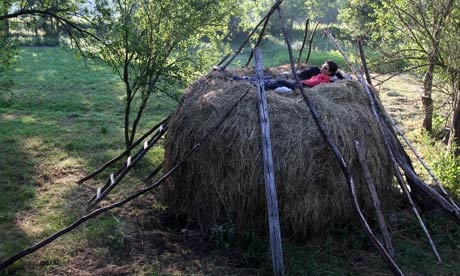 Mircea on the hayrick bed in ColtiI do have a few reservations about this plan. I’m expecting to have tiny burrowing insects tickling me to death all night long. There’ll be no escape either, since the darkness below will be full of marauding bears, dogs and wolves. Mircea, however, is confident that we will be comfortable. He rigs up a plastic sheet to hold back the dew, and we unfurl our sleeping bags and settle down. Very quickly I realise how wrong I was: it is like sleeping on a feather bed as tall as a house. I wake once and admire the stars. Dawn comes wrapped in mysterious scarves of mist winding around the walnut trees. We head for the cottage and breakfast – all homegrown and homemade – of eggs, cheeses, milk, bread and a tot of plum brandy.
Mircea on the hayrick bed in ColtiI do have a few reservations about this plan. I’m expecting to have tiny burrowing insects tickling me to death all night long. There’ll be no escape either, since the darkness below will be full of marauding bears, dogs and wolves. Mircea, however, is confident that we will be comfortable. He rigs up a plastic sheet to hold back the dew, and we unfurl our sleeping bags and settle down. Very quickly I realise how wrong I was: it is like sleeping on a feather bed as tall as a house. I wake once and admire the stars. Dawn comes wrapped in mysterious scarves of mist winding around the walnut trees. We head for the cottage and breakfast – all homegrown and homemade – of eggs, cheeses, milk, bread and a tot of plum brandy.
The day is for hiking: exploring the forests and upper valleys of the area where there are cave churches, remnants of an eremitic society that came here to hide from Mongol and Ottoman invaders. We stop frequently because neither of us can bear to pass a patch of wild strawberries or a laden mulberry tree. One chapel is accessed only by a ladder up a rock face, others are tucked inside natural niches or at the foot of huge crags.
Eventually we get to the fountain of eternal youth, as Mircea has billed it, only to discover that a farmer has capped it with a concrete lid. It’s so heavy that I put on 10 years in shifting it in order to get a few sips of the sulphurous brew below. Legend has it that King Luanei of Colchis was the only person allowed to drink this divine nectar.
There are other stories too, told to us by 13-year-old Andrea: caves that transport you to faraway places, and grottoes where candles cannot be lit.
“They are not stories,” she insists with all the certainty of youth. “They are true.”
The area is certainly mysterious, filled with strange phenomena such as volcanoes of cold bubbling mud and seams of ancient amber.
Next day is going to be a big biking marathon so we hit the hay early. By eight next morning we are already pedalling down the valley, greeting peasants driving to their fields in horse-drawn carts, a form of transport that outnumbers cars here.
We stop to browse on the sour cherry trees, a fruit so delicious I cannot believe I’ve lived so long without it. There is an exciting crossing of a swaying rope bridge, then a few miles on a main road. Mircea apologises profusely for the traffic: it’s almost as bad as a Northumbrian B-road on Christmas Day.
We turn on to a rough mountain track and climb steadily through dark pine forests. As we approach the pass, magnificent views open out: deep forested valleys, exposed ridges and occasional hamlets. Unfortunately, at one of these we are misdirected and end our climb with a soul-destroying push up a rutted footpath.
On the far side things improve. There is a wooden shrine containing a wooden jug of cool water for travellers, the cows have scarlet pom-poms tucked behind their ears, and the puddles are filled with happy honking frogs. We cycle down in late afternoon sun, reaching the small town of Lopatari as the sun sets.
“We could reach the pension in about an hour from here,” says Mircea, “but there’s a hunter lives nearby … ”
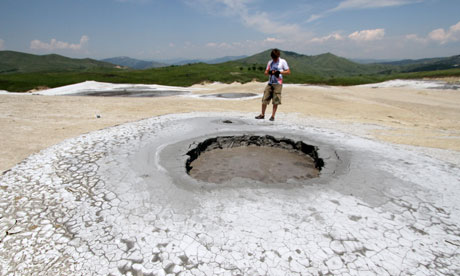 A volcaono of cold mudNelu turns out to be something of a character, as are all his family. His father, a shepherd, lives a totally self-sufficient life, refusing to go into town. Nelu owns a lorry, and that brings in some money, but otherwise he follows his father’s lead, stocking his larder with deer and wild boar to go with bottled preserves and dried foods. We settle down to a feast: wild boar with homegrown polenta, wild mushrooms with pickles, deer stew with cabbage and bread, cheeses and cake, washed down with a decent homemade rosé and plum brandy.
A volcaono of cold mudNelu turns out to be something of a character, as are all his family. His father, a shepherd, lives a totally self-sufficient life, refusing to go into town. Nelu owns a lorry, and that brings in some money, but otherwise he follows his father’s lead, stocking his larder with deer and wild boar to go with bottled preserves and dried foods. We settle down to a feast: wild boar with homegrown polenta, wild mushrooms with pickles, deer stew with cabbage and bread, cheeses and cake, washed down with a decent homemade rosé and plum brandy.
Nelu tells stories of hunting: the lynx who is so fast and elusive, the wolves that come in winter, the bear with cubs who chased him up a tree, tearing at his back – it was his rucksack that saved his life that day. When we are finished and dusk is falling, he pushes back his chair and says, “Come on. We’ll try and find a bear.”
Back in the bog rhubarb, we have started finding bear tracks. “Here’s a mother with a cub,” says Nelu, pointing to some marks. “They are recent, but heading up the hill so we must have missed them.”
We walk quickly and quietly back up to the meadow and emerge on a ledge where flames are licking from among the flowers. It’s a set of natural gas fumaroles, eternally sending spouts of yellow skywards. We give up on the bears and sit next to the fire, enjoying the warmth and the weird magic of the place. According to Nelu, there are no stories or legends attached to the gas jets. “Don’t you have them in your country?” he asks. In this forgotten corner, where there are volcanoes of cold mud, caverns that spirit people away to faraway lands, and fountains of youth, eternal flames are nothing out of the ordinary.




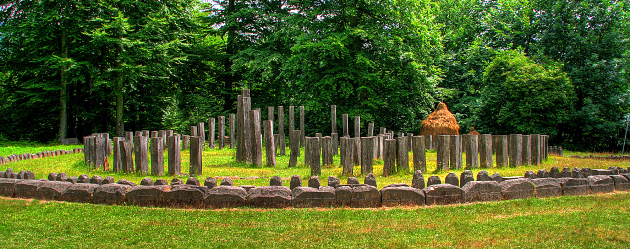

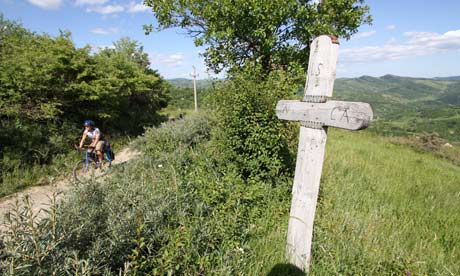

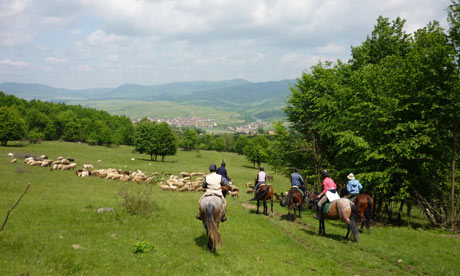
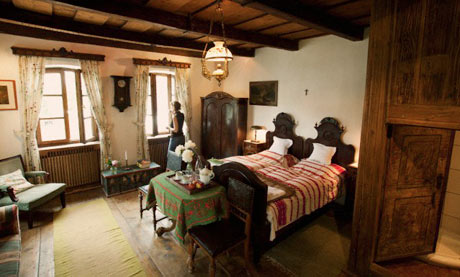 Count Kalnokys’s guesthouse. Photograph: Catherine Karnow/CorbisAnd I was entranced by the sight, only a few strides outside the guesthouse, of storks in slapdash nests at the top of telegraph poles. Josef had passed on another of his revelations about the storks: every year, he insisted, they leave
Count Kalnokys’s guesthouse. Photograph: Catherine Karnow/CorbisAnd I was entranced by the sight, only a few strides outside the guesthouse, of storks in slapdash nests at the top of telegraph poles. Josef had passed on another of his revelations about the storks: every year, he insisted, they leave 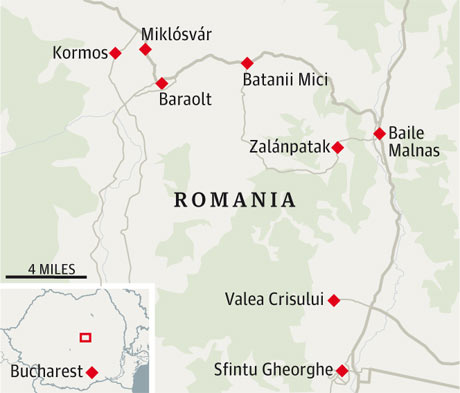 Map showing places on Kate’s tripThe weather was poor but better than advertised. If I were to return, I would go for September or October (summer can be roastingly hot). Yet it is a measure of how stunning Transylvania is that even under grey skies it captivates. The sense of being in a fairytale persists beyond the guesthouse door and into the landscape itself.
Map showing places on Kate’s tripThe weather was poor but better than advertised. If I were to return, I would go for September or October (summer can be roastingly hot). Yet it is a measure of how stunning Transylvania is that even under grey skies it captivates. The sense of being in a fairytale persists beyond the guesthouse door and into the landscape itself.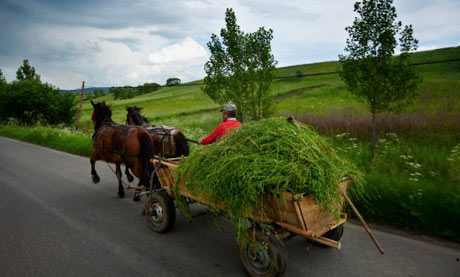 Traditional farming in Miklósvár. Photograph: Catherine Karnow/CorbisThe warmth of all the Romanians we met was disarming, and our hosts in Little Bacon were especially attentive, putting aside time to entertain us. Mr Antal kissed our hands and played us old Caruso recordings on an antique gramophone. Mrs Antal shared her hopes that Romania was about to turn a corner politically.
Traditional farming in Miklósvár. Photograph: Catherine Karnow/CorbisThe warmth of all the Romanians we met was disarming, and our hosts in Little Bacon were especially attentive, putting aside time to entertain us. Mr Antal kissed our hands and played us old Caruso recordings on an antique gramophone. Mrs Antal shared her hopes that Romania was about to turn a corner politically.


